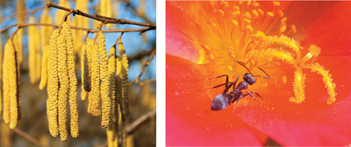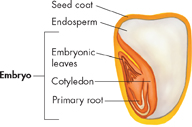
FIGURE 24–4 Pollination The appearance of a flower often indicates how it is pollinated. The flowers of an oak tree (left) are typical of wind-pollinated flowers in that they are small and not very showy but produce vast amounts of pollen. In contrast, many animal-pollinated flowers are large and brightly colored (right).
Pollination Pollination is the transfer of pollen to the female portions of the flower. Some angiosperms are wind pollinated, but most are pollinated by animals. These animals, mainly insects, birds, and bats, carry pollen from one flower to another. Because wind pollination is less efficient than animal pollination, wind-pollinated plants, such as the oak tree in Figure 24–4, rely on favorable weather and sheer numbers of pollen grains to get pollen from one plant to another. Animal-pollinated plants have a variety of adaptations, such as bright colors and sweet nectar, to attract and reward animals. Animals have evolved body shapes that enable them to reach nectar deep within certain flowers. For example, hummingbirds have long, thin beaks that can probe deep into flowers to reach the nectar supply.
Insect pollination is beneficial to insects and other animals because it provides a dependable source of food—pollen and nectar. Plants also benefit because the insects take the pollen directly from flower to flower. Insect pollination is more efficient than wind pollination, giving insect-pollinated plants a greater chance of reproductive success. The efficiency of insect pollination may be one of the main reasons why angiosperms displaced gymnosperms as the dominant land plants over the past 130 million years.
BUILD Vocabulary
RELATED WORD FORMS Several word forms are derived from the word pollen. Pollination is the transfer of pollen from one flower to another. A pollinator is an animal that moves pollen.
Fertilization If a pollen grain lands on the stigma of a flower of the same species, it begins to grow a pollen tube. Of the pollen grain's two cells, one cell—the “generative” cell—divides and forms two sperm cells. The other cell becomes the pollen tube. The pollen tube contains a tube nucleus and the two sperm cells. The pollen tube grows into the style, where it eventually reaches the ovary and enters an ovule.
Inside the embryo sac, two distinct fertilizations take place—a process called double fertilization. First, one of the sperm nuclei fuses with the egg nucleus to produce a diploid zygote. The zygote will grow into the new plant embryo. Second, the other sperm nucleus does something truly remarkable—it fuses with two polar nuclei in the embryo sac to form a triploid (3N) cell. This cell will grow into a food-rich tissue known as endosperm, which nourishes the seedling as it grows.  The process of fertilization in angiosperms is distinct from that found in other plants. Two fertilization events take place—one produces the zygote and the other a tissue, called endosperm, within the seed. The rich supply of endosperm, as shown in the corn seed in Figure 24–5, will nourish the embryo as it grows.
The process of fertilization in angiosperms is distinct from that found in other plants. Two fertilization events take place—one produces the zygote and the other a tissue, called endosperm, within the seed. The rich supply of endosperm, as shown in the corn seed in Figure 24–5, will nourish the embryo as it grows.

FIGURE 24–5 Inside a Corn Kernel The endosperm and embryo of a corn seed are the result of double fertilization.
Table of Contents
- Formulas and Equations
- Applying Formulas and Equations
- Mean, Median, and Mode
- Estimation
- Using Measurements in Calculations
- Effects of Measurement Errors
- Accuracy
- Precision
- Comparing Accuracy and Precision
- Significant Figures
- Calculating With Significant Figures
- Scientific Notation
- Calculating With Scientific Notation
- Dimensional Analysis
- Applying Dimensional Analysis




